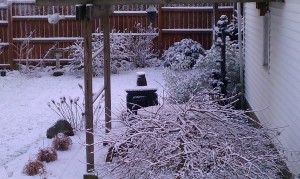Wilt-pruf for the winter, the who what and why and what to do with the areas of lawn that receive a lot of salt in the winter.
Plants stomas are much like our skin pores and moisture can be lost through these in the same way we lose moisture as we sweat. Plants transpire much like we perspire and the dry cold air wicks the moisture away from the leaves. A Rhododendron will try to cut back on exposed tissue and will curl its leaves up much like tubes in reaction to the drying winds. During harsh winters this reaction is usually to no effect. When spring arrives there are many plants including Rhododendron that are suffering from winter desiccation and in need of much TLC.
The best preventive measure is to pay attention to which of your landscape plants have been suffering through the winters, and protect them before the winter winds arrive. You can wrap your plants in burlap or you can buy an Anti-transpirant or Wilt-pruf. An Anti-transpirant is safe for the environment and is a waxy type substance that acts as an insulator for the plants. Usually you will mix the anti-transpirant concentrate with water in a clean horticultural sprayer and apply it liberally to the plant tissue both above and below until the product is dripping off of the leaves. For NE Ohio you will want your first winter application of this product on or around November 15th. Before applying the Wilt-pruf, make sure there has been at least 4-5 days of forty degree temps or higher. This will allow the spray to go on evenly and also allows the product time to dry so it will not freeze to the plants tissue. You will want to repeat this process again on or around January 15th, and be mindful of the temperatures.
You can apply an Anti-transpirant to many plants including; Arborvitae, Inkberry, Rhododendron, Azalea and more. The only draw back is sometimes the second application, the one in January, can cause some buds of the Rhododendron and Azaleas to be glued shut and it is possible to miss out on some bloom.
If you have areas of lawn that receive a lot of salt from snow and ice removal of your hard surfaces, such as walkways and driveways in the winter, then you may want to apply some Gypsum to these lawn areas this week to help it combat salt desiccation. The gypsum will help the precipitation and added salt from winter leach through the lawn areas more quickly. Or you can try to flush the area out in the spring with lots and lots of water.
The temperatures should continue to warm this week and give us a bit of reprieve before our true winter begins.
So…..get the rest of your leaves done , get your Wilt pruf on, get your lawn to the right height once this snow melts – the holidays are a coming and you want your landscape well at rest by then!




